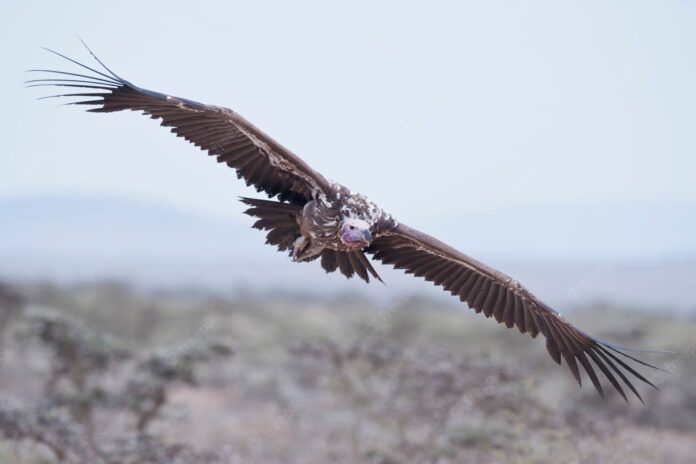Vultures are the least popular birds when it comes to beauty, but they have some awesome features that make them unique. First of all, vultures are among the fierce raptors of the sky. They may feast on corpses, but some of them are capable of hunting by themselves as well. In fact, vultures are very fascinating birds to know but not many people are interested in them because of their appearance. Or maybe due to the fact that cartoons depict them as the bad guys, so most of us don’t like them. Today, we focus on the largest vultures in the world that have been roaming the sky. Don’t forget to share your thought with us on which of the largest vultures you think is the most interesting.
7California Vulture
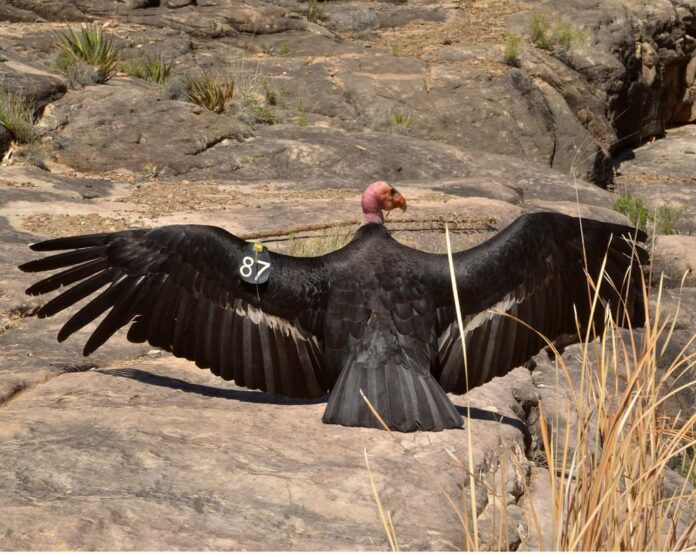
Length: 62 – 81 centimeters
Weight: 0.8 – 2.41 kilograms
Also known as Turkey Vultures, Turkey Buzzards, or simply Buzzards, California vultures are large soaring birds that feed on carrion. These vultures are found in the lower forest zones and steppe zones from southern Canada throughout the United States, South America, and the Caribbean. These buzzards are almost exclusively scavengers, and they usually form communal roosts which facilitate group foraging and social interactions. Their roosts range from a few to several thousand vultures.
California vultures are often seen standing in a spread-winged stance known as the Horaltic Pose. The pose serves multiple functions such as drying the wings, warming the body, and baking off bacteria. One of their weird behavior is that they vomit their food as a method of self-defense. If the vulture feels disturbed or harassed, it will throw up on the animal that is bothering it. Even baby vultures will also do the same to other animals. Like parents, like babies indeed.
Offspring
Speaking of babies, this species of vulture has another different way of building their nest. Well, by not building one. They simply lay their eggs on the ground on a cliff or rock crevice, in a cave, or inside a hollow tree. Generally, the females lay two eggs if not one while sometimes it could be three which is very rare. Both parents feed the chicks by regurgitating food for them, and care for them for about 10 to 11 weeks.
Usually, farmers kill them out of confusion about similar black vultures’ tendency that attacks and kills newborn cattle. The thing is that Turkey vultures don’t kill live animals, they are scavengers and they feed entirely on carrion. The good thing is they are on the list of Least Concern, and their population seems to be stable.
6Indian Vulture
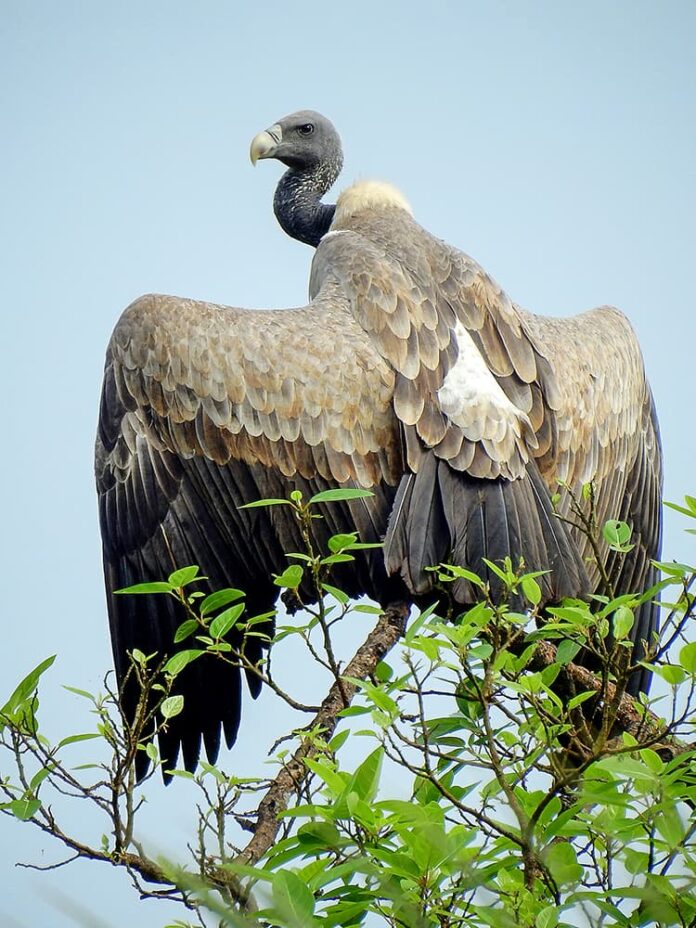
Length: 80 – 103 centimeters
Weight: 5.5 – 6.3 kilograms
There is not much detailed information about this species of vulture, according to my research. The basic data about them is mainly about their habitat and behavior. So Indian vultures are native to India, Pakistan, and Nepal, and they are on the list of Critically Endangered. Among the largest vultures, this one is medium in size and a little bulky which is less heavy compared to the others. Yet just like everyone in the family, they are scavengers feeding mostly on the carcasses of dead animals.
Indian vultures often move in flocks, and they mainly breed on cliffs and trees or high man-made structures. We all know that vultures lay just one or two eggs per year, so their population does not grow very fast. On top of that, this species has been facing a great decline in its population due to diclofenac poisoning. Throughout the 1990s and 2000s, these vultures are dying while performing their essential ecosystem service for us.
Diclofenac is a non-steroidal anti-inflammatory drug given to working animals to reduce joint pain to keep them working longer. When those animals die, vultures feed on their carcasses along with the drug. To several species of vultures, diclofenac causes kidney failures which leads to the death of many. When many of them die, the population of feral dogs and rats that bring zoonotic diseases begins to increase. And that my friend, is a doom.
Well, the good thing is India is trying to find ways to maintain and increase the number of this vulture species. Hopefully, things will get better in the near future with more population of them.
5Ruppell’s Vulture
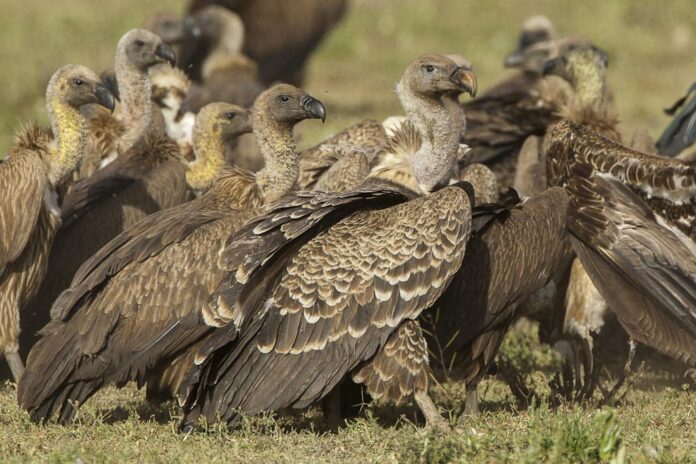
Length: 85 – 103 centimeters
Weight: 6.4 – 9 kilograms
Here we have another big vulture that completes the list of the largest vultures in the world. Ruppell’s vultures are big vultures that you can find throughout the Sahel region in the grasslands, mountains, and woodlands of Central Africa. They are social birds; hence, they nest in colonies of about 100 pairs when they are in mountainous habitats. Not different from their relatives, they are scavengers whose menu consists of carcasses and remains of dead animals; yum.
Just like everyone on the list, Ruppell’s vultures are also monogamous, and they make great parents. After their courtship, the couples will work together to build a nest using sticks, grass, and leaves. Some they gathered while the others they stolen from other nests, well we are selfish sometimes so don’t judge them. These vultures usually build their nests on cliffs, and the female lay one egg at a time. Both parents incubate the egg over a period of 55 days, and take care of the chick for about 150 days.
In many African cultures, vultures are used for medicine as well as black magic practices. People believe that vultures have clairvoyant abilities and that they help increase a child’s intelligence. In 2015, the species of this vulture is listed as Critically Endangered due to the rapid decline of their population. Their population is dropping due to many factors such as habitat loss, incidental poisoning, and persecution. Till today, their numbers are still decreasing.
Fact: Ruppell’s Vultures are not only one of the largest vultures but also the highest-flying birds in the world as well.
4Cinereous Vulture
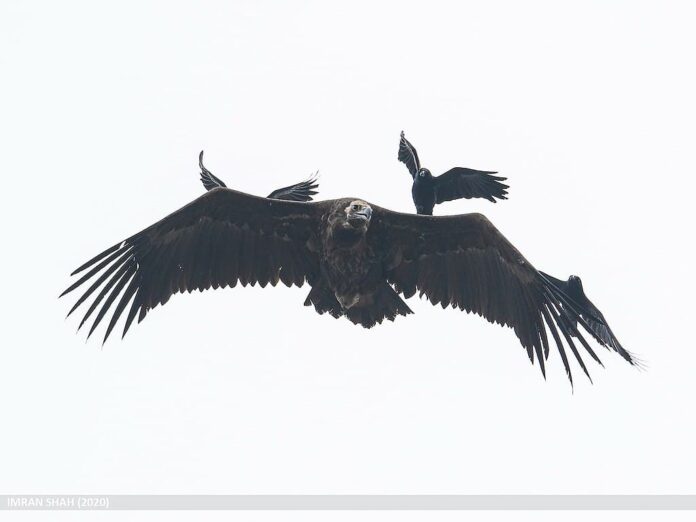
Length: 98 – 102 centimeters
Weight: 14 kilograms
Cinereous vultures aka black vultures or monk vultures are one of the two largest Old World vultures. They are also among the heaviest and largest vultures in the world as well. These vultures nests in trees and sometimes on cliffs, and just like most vultures, they are monogamous. The couples usually build huge nests that they reuse each year during the breeding season.
The awesome thing about Cinereous vultures is that they have a specialized type of hemoglobin in their blood. That allows them to effectively absorb oxygen even at a great height, especially when they are searching for carcasses from above. Being a scavenger, cinereous vulture feeds on carrion ranging from large mammals to fish and reptiles. The flight of these vultures is slow and buoyant with deep and heavy flaps when necessary.
Black vultures build their nests in trees and on cliffs high above the ground using sticks and twigs. Both males and females cooperate in rearing their young, and they are monogamous. They are huge in size and dark in color, and they are very silent generally. Sometimes, they let out a few querulous mewing, roaring, or guttural cries solely between adults and their offspring at the nest site.
More About Black Vultures
These large vultures have some special adaptations such as their massive beak for feeding on tough materials like sinew, dry skin, and muscle. Another thing is the short feathers on their head and neck that keep them healthy by preventing gore from accumulating. The most special adaptation is their sharp eyesight which helps to spot carcasses from far above.
Their number one threat in the last 200 years is poison bait that people put out to kill dogs and other predators. As a matter of fact, locals tend to shoot vultures of all species if they see one. In Armenia, poaching for trophy hunting of these large vultures is very common. Apart from human activities, the destruction of their habitats also plays a part in the decline of their number. The status is now Near Threatened, and their population worldwide is around 4500-5000 individuals.
3Cape Vulture
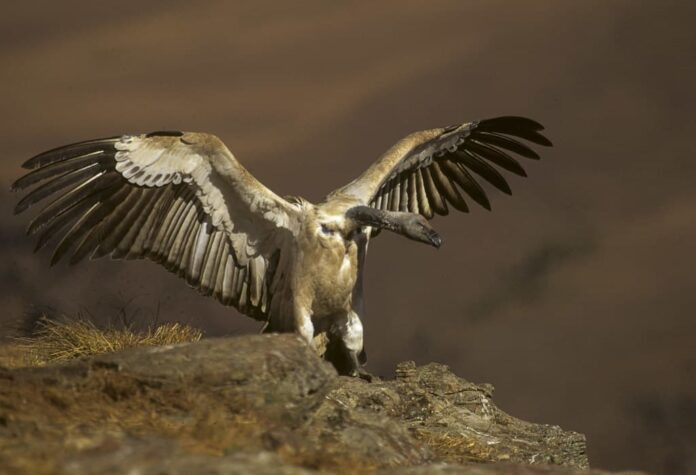
Length: 96 – 115 centimeters
Weight: 7 – 11 kilograms
Also goes by the name of Kolbe’s vulture, cape vultures are one of the largest vultures in the world. At the same time, they are also one of the largest southern African vultures with the lightest color as well. You can find them in rocky areas like land cliffs, mountain peaks, open grassland, arid savannah, and steppes. These vultures feed solely on deceased animals, and they are capable of holding out against jackals and even warthogs for food.
The interesting thing about them is that they are the only vultures in South Africa to live together in large colonies. Cape vultures nest on cliff ledges in communities of at least 6 pairs, and the females lay one egg per year. Both parents incubate the egg over a period of 57 days, and the young will depend on its parents for up to 221 days. After that, the young birds will form groups to forage and roost some distance from their breeding sites.
Unfortunately, these large vultures are classified as endangered due to a large number of threats. The population decreases due to the short amount of carrion during nesting, poisoning, electrocution, habitat loss, and many more. Also, they are facing a very high risk of extinction in the wild. Little do we know that they play a vital role in the ecosystem by cleaning up dead carcasses.
Probably because of their ability to find animal carcasses almost immediately after their death, some people consume their brains. In order to seek such supernatural abilities, people in some cultures hunt vultures just to eat their brains. Their population has decreased remarkably in the past few decades. Perhaps our generations in the future will know them as one of the extinct vulture species instead.
2Andean Condor
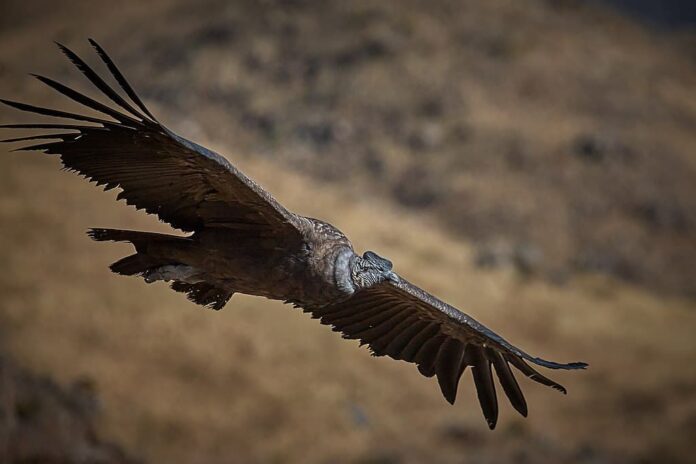
Length: 1 – 1.3 meters
Weight: 7.7 – 15 kilograms
Besides being one of the largest vultures, the Andean condor is also the largest flying bird in the world as well. On top of that, their enormous size and wingspan of over 3 meters make them the largest raptors in the world. These vultures are huge; therefore, their menu consists of large carcasses such as those of deer or cattle. The irony is that their impressively large wings tend to give them hard time staying aloft when in flight. That is because they are a little too heavy, but still, they can soar up to 5,500 meters in windy areas.
The weird thing is that these vultures only produce one egg every two years. Also, most of them don’t build a safe and protective nest for their rare egg. Instead, they simply lay it on a bare cliff edge; so much for parents, right? However, both of the parents incubate the eggs and raise the chick together as they give all the care and attention. Baby condors usually leave their parents in their second year of life before spending around 6 years to reach full adulthood.
You can find them in the Andean Mountain region of South America as well as coastal areas and some desert areas. Like I mentioned above that they prefer large carcasses, and Andean condors are the vacuum cleaners along the coastline. The locals won’t have to worry about any smelly seal, fish, or whale carcasses washed up on shore at all. Andean condors will handle those carcasses with the skill to ensure clean beaches.
Population
They are not only entitled as one of the largest vultures but also a national symbol of Argentina, Bolivia, Chile, Colombia, Ecuador, and Peru. They play an important role in the folklore and mythology of the Andean regions. Nowadays, they are considered Near Threatened due to habitat loss and secondary poisoning from carcasses killed by hunters. Andean condors are in danger of extinction throughout all or a significant portion of their range. There are only about 6,700 of them left in the world now which is not a high number at all.
1Lappet-Faced Vulture
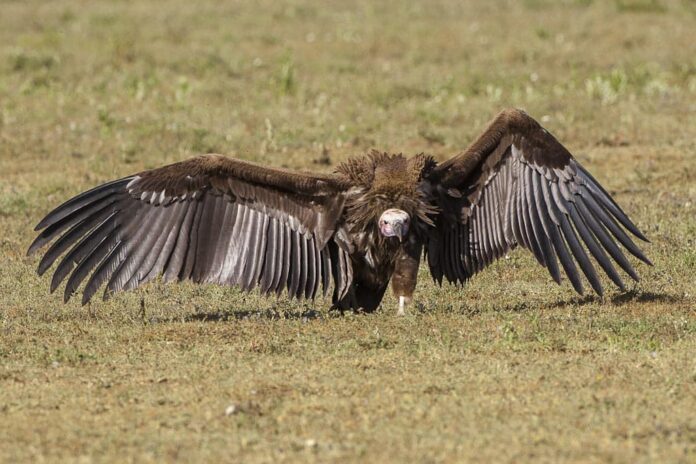
Length: 1 – 1.5 meters
Weight: 6.2 – 13.6 kilograms
Meanwhile, most large vultures are large in size and heavy in mass, this one displays a different trait. Lapped-Faced vultures are the largest vultures in Africa, and these birds have heavy heads and powerful massive beaks. Their beak allows them to tear the hides, tendons, and any other coarse tissue from their meal. The prey might be too tough for most scavengers, but not for lapped-face vultures.
On top of that, lapped-faced vultures are one of the most aggressive birds in Africa. Plus with their dominating size, they often scare off smaller vultures and take their food. Speaking of food, they don’t feed strictly on carrion, they sometimes sit by termite mounds or locust nests to feed on them. While some other times when they prefer a more fancy meal, they will raid flamingo colonies to kill them and eat their eggs.
Habitats
You can find them in dry savannah, desert, or semi-arid areas with short grass throughout Africa and the Middle East. The unique part is that they are generally solitary birds, and they don’t nest in colonies like most vultures at all. During the breeding season, the couples will build a huge nest with a pile of neatly formed sticks. Oh yes, these raptors are perfectionists when it comes to their nests.
The nest is often lined with green leaves along with animal hair and skins. Nice interior designing skill, though. The females usually have one or two eggs, and both parents incubate the eggs for about 56 days. Their young usually fledge at 124 to 135 days old, while some can be dependent on their parents for up to a year. Lapped-Faced vultures are considered Vulnerable, and there are about 9,000 individuals in the world nowadays.
Related Post: Largest Eagles With Longest Wingspan

